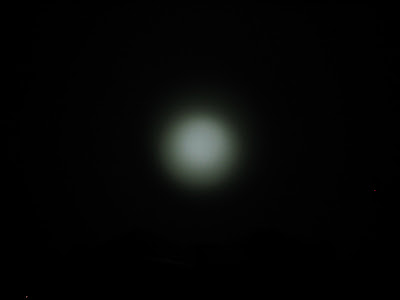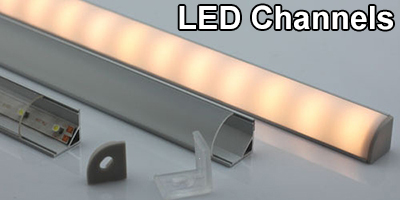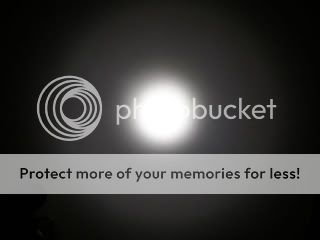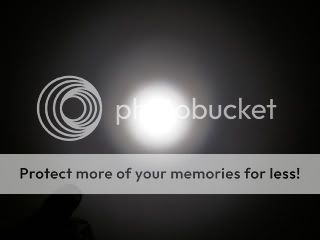WadeF
Flashlight Enthusiast
Alright, my Surefire E1B arrived today. I like it! The UI is simple to use. I took some beam shots, and some LUX readings. I was dissapointed when I did the LUX readings though, my SF L1 Cree out performs the E1B, it has slightly more throw and output! Maybe SF should adjust their ratings, maybe the SF L1 should be rated at 80 lumens as well? Or the E1B should be listed as 65 lumens like the L1, they are both pretty close, the L1 only slightly edges it out, but I was expecting, from SF's marketing and ratings, that the E1B would have more output. Maybe I got a dud E1B? Or maybe SF is being less conservative with the E1B.
Here is a quick pic of the contenders, SF L1, E1B, Fenix P2D (yeah, some GITD stuff installed)

I'll start with LUX readings, then get into beam shots.
Surefire L1 - 3,540 LUX at 1 meter
Surefire E1B - 3,110 LUX at 1 meter
Fenix P2D Q2 - 2,000 LUX at 1 meter
I used fresh Titanium cells for these tests, all voltage matched. The SF batteries included with the L1 and E1B were kinda low, and only read 3,300 for the L1, and 3,000 for the E1B.
So the L1 should throw the best as it has the most intense spot, maybe it's focused better?
The next test was to approximate total output, these #'s are only useful for comparing these 3 lights from this test only. I set up a bounce box, and recorded the lux reading in the box, being careful to put up a baffle around the sensor so any side spill wouldn't hit it, or the area of the box it was reading, etc.
Surefire L1 - 140 LUX
Surefire E1B - 127 LUX
Fenix P2D Q2 - 190 LUX
As you can see the Surefire L1 has slightly more total output, and the Fenix P2D has more than either, about 50% more than the E1B.
So if the E1B is 80 SF lumens, 80 lumens + 50% = 120 lumens. That's about where most people would put the Fenix P2D Q2 for out the front lumens.
The Surefire L1 seems more under rated, when I initially did a bounce ttest with it I felt 65 lumens was under rated, and now it seems that maybe the case, or I got a good L1. The Fenix is about 35% brighter than the L1, so 65 lumens + 35 % = 88 lumens, which doesn't sound right. The Fenix P2D Q2 is almost certainly putting out more than 88 lumens.
The Fenix is about 35% brighter than the L1, so 65 lumens + 35 % = 88 lumens, which doesn't sound right. The Fenix P2D Q2 is almost certainly putting out more than 88 lumens.
Maybe Surefire rated the L1 base on average output from start up to the end of it's regulation? Who knows.
Well, now for beam shots, ISO 50, f2.8, 1/10sec, WB aylight:
aylight:
Surefire L1 Cree LOW:

Surefire E1B LOW:

Fenix P2D Q2 LOW:

Surefire L1 HIGH:

Surefire E1B HIGH:

Fenix P2D Q2 TURBO:

You can see how the SF's create a more intense hot spot, which makes these little lights good throwers. The P2D has a larger hot spot, not as intense, but brighter spill. To better show the spill I took shots to show the spill, these images were taken at 1 second to allow for the spill to be more visible, note the red pillows are visibly brighter with the P2D:
Surefire L1 HIGH:

Surefire E1B HIGH:

Fenix P2D Q2 TURBO:

That should show how the P2D has a larger hot spot, and brighter spill, and that's the Q2 version, I'm still waiting on my P2D Q5, but it should only be slightly brighter.
As far as tints, my L1 is a bit on the green side, the E1B looks a bit purple when compared side by side to the L1. These pics show a tint difference, but not exactly what I see, the E1B looks pretty good in this shot, the L1 a bit cooler:
Back to 1/10 sec:
SF L1 left, SF E1B right, both on HIGH:

SF L1 left, SF E1B right, both on LOW:

Here is a quick pic of the contenders, SF L1, E1B, Fenix P2D (yeah, some GITD stuff installed)
I'll start with LUX readings, then get into beam shots.
Surefire L1 - 3,540 LUX at 1 meter
Surefire E1B - 3,110 LUX at 1 meter
Fenix P2D Q2 - 2,000 LUX at 1 meter
I used fresh Titanium cells for these tests, all voltage matched. The SF batteries included with the L1 and E1B were kinda low, and only read 3,300 for the L1, and 3,000 for the E1B.
So the L1 should throw the best as it has the most intense spot, maybe it's focused better?
The next test was to approximate total output, these #'s are only useful for comparing these 3 lights from this test only. I set up a bounce box, and recorded the lux reading in the box, being careful to put up a baffle around the sensor so any side spill wouldn't hit it, or the area of the box it was reading, etc.
Surefire L1 - 140 LUX
Surefire E1B - 127 LUX
Fenix P2D Q2 - 190 LUX
As you can see the Surefire L1 has slightly more total output, and the Fenix P2D has more than either, about 50% more than the E1B.
So if the E1B is 80 SF lumens, 80 lumens + 50% = 120 lumens. That's about where most people would put the Fenix P2D Q2 for out the front lumens.
The Surefire L1 seems more under rated, when I initially did a bounce ttest with it I felt 65 lumens was under rated, and now it seems that maybe the case, or I got a good L1.
Maybe Surefire rated the L1 base on average output from start up to the end of it's regulation? Who knows.
Well, now for beam shots, ISO 50, f2.8, 1/10sec, WB
Surefire L1 Cree LOW:
Surefire E1B LOW:
Fenix P2D Q2 LOW:
Surefire L1 HIGH:
Surefire E1B HIGH:
Fenix P2D Q2 TURBO:
You can see how the SF's create a more intense hot spot, which makes these little lights good throwers. The P2D has a larger hot spot, not as intense, but brighter spill. To better show the spill I took shots to show the spill, these images were taken at 1 second to allow for the spill to be more visible, note the red pillows are visibly brighter with the P2D:
Surefire L1 HIGH:
Surefire E1B HIGH:
Fenix P2D Q2 TURBO:
That should show how the P2D has a larger hot spot, and brighter spill, and that's the Q2 version, I'm still waiting on my P2D Q5, but it should only be slightly brighter.
As far as tints, my L1 is a bit on the green side, the E1B looks a bit purple when compared side by side to the L1. These pics show a tint difference, but not exactly what I see, the E1B looks pretty good in this shot, the L1 a bit cooler:
Back to 1/10 sec:
SF L1 left, SF E1B right, both on HIGH:
SF L1 left, SF E1B right, both on LOW:
Last edited:




